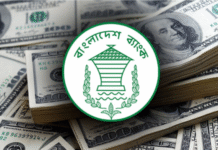The United Nations on Saturday projected that Bangladesh’s economy would grow by 7.8 per cent in the current fiscal year of 2019-2020, lower than the country’s GDP growth of 8.15 per cent in the previous FY 2018-2019.
Earlier on January 9, the World Bank in its report titled ‘Global Economic Prospects, January 2020’ also projected a slower pace of gross domestic product (GDP) growth at 7.2 per cent for the FY2020.
The UN, in its latest World Economic Situation and Prospects report released on the day, also mentioned that Bangladesh’s strong dependence on the textiles and garment industry was a major weakness of the economy.
The drivers of the current economic growth of Bangladesh and some other South Asian countries also exposed significant weaknesses as all of these countries rely heavily on a small number of sectors for their economic development, it said.
‘Bangladesh continues to depend strongly on the textiles and garment industry, a sector that ranks poorly in terms of product complexity, rendering the country’s economy among the least complex in the world and leaving it highly exposed to external shocks,’ the report said.
Bangladesh, Bhutan and Maldives, however, have taken advantage of significant economic opportunities created by global trade disputes and geopolitical tensions, it added.
‘Driven by the expansion of its garment industry, which has prospered partially as a result of trade disputes between the United States and China, Bangladesh enjoyed exceptional GDP growth of 8.1 per cent in 2019,’ said the report.
Development prospects are also held back by persistent and often expanding inequalities in the region.
Referring to the UNESCAP (2018), the report said that income inequalities increased in India, Bangladesh and Sri Lanka between the early 1990s and the early 2010s.
Gender inequalities also remain high in the sub-region, it added.
In the report, the UN also forecasted 7.1 per cent GDP growth for the FY2020‑2021.
Annual inflation rate may also rise to 5.9 per cent in FY2020 from that of 5.1 per cent in FY2019, the report projected.
Regarding the youth manpower, it said that a sizeable population remains outside the labour force as a third of the youth in Bangladesh and some other South Asian countries including Sri Lanka, Pakistan and Afghanistan are not in education, employment or training (NEET).
According to the report, Bangladesh, one of the 15 least developed countries (LDC), is growing above at least 7 per cent as per the target 8.1 of the sustainable development goals (SDGs).
The report said that several countries, including Bangladesh, were still involved in the construction of new coal-fired power plants despite an acceleration in the pace of decommissioning and cancellation of 1,034 planned or announced projects since 2015.
This demonstrates a persistent lack of recognition of the urgency of transitioning towards clean energy, encouraging financial investment in plants that are likely to become stranded long before the end of their technical life of up to 75 years, it said.
Bangladesh is in the third position with a 2,774-megawatt capacity of proposed and new coal plants in 2019, it said, adding that the total world capacity of proposed and new coal plants in the year was 51,855 megawatts.









